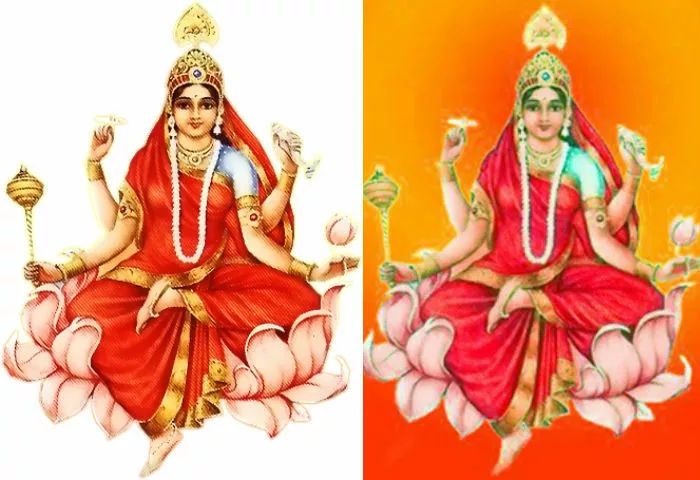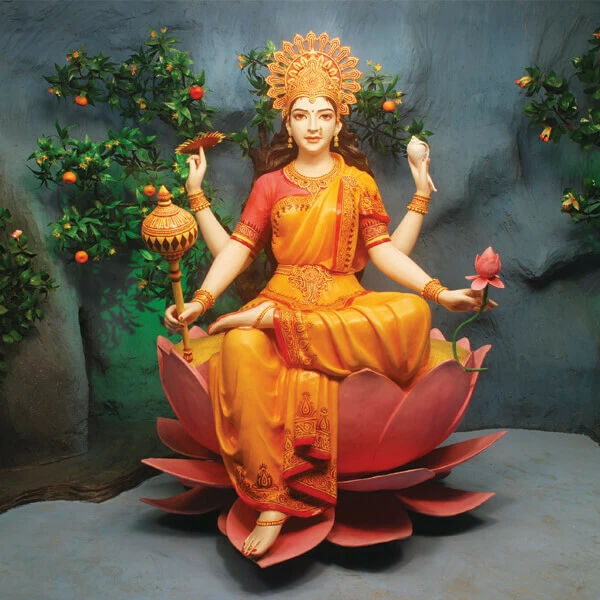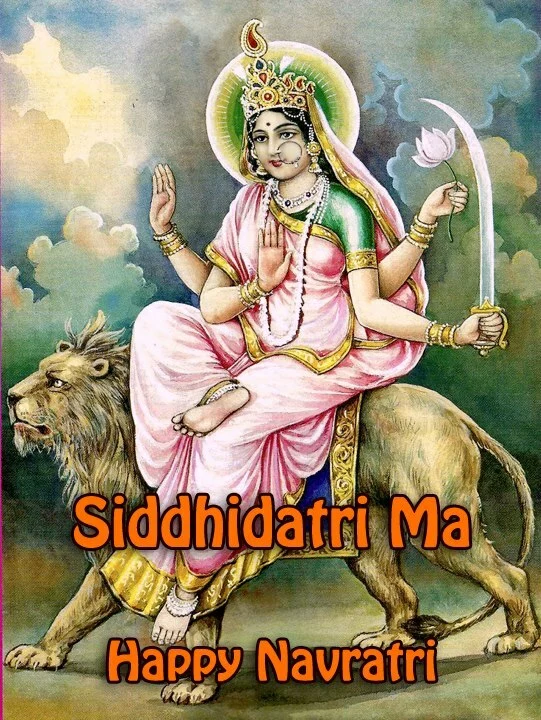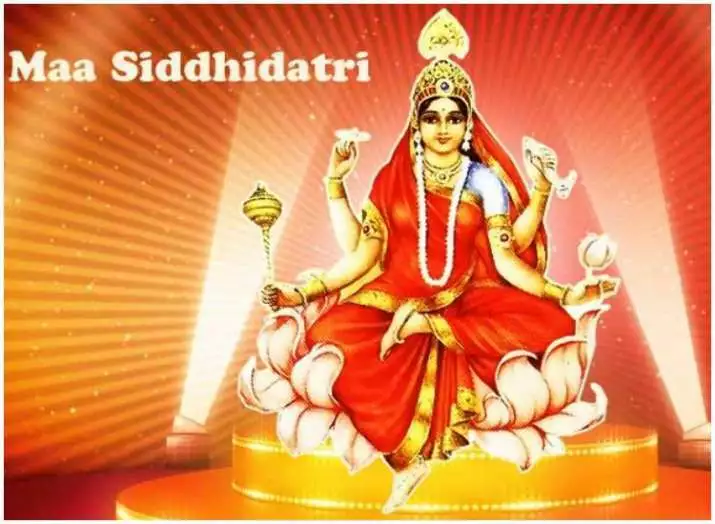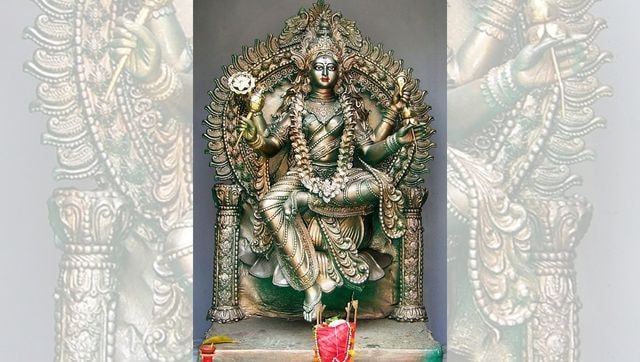#Happy #Navratri Day 9
Navami

#Maa #Siddhidatri Puja
Ram Navami
30th
March 2023
(Thursday)
Navratri 9: #Peacock #green
Day 9 is the last day of the Navratri festival. The day is called Navami. #Goddess Siddhidatri is worshipped on this day. Peacock green is the colour of this day. It is believed that one side of Lord Shiva's body is that of Goddess Siddhidatri. Therefore, he is known by the name of #Ardhanarishwar. As per the scriptures, Lord #Shiva attained all the siddhis by worshipping this Goddess.
Siddhidatri Mata is worshipped on the ninth day of Navratri. Her names means: Siddhi - spiritual power & ‘Datri’ - the giver. The goddess is known for removing ignorance and giving knowledge to realize the eternal power, which is running the entire cosmos.
About Siddhidatri
Maa Siddhidatri is seated on the lotus and rides a lion. She has four arms, where one right arm holds the Gada (mace), other one holds the Chakra (discus weapon), one left arm holds lotus, and the other one holds Shankh (conch). She is the Goddess who holds all the Siddhis.
Legend
Lord Shiva worshipped Goddess Siddhidatri to attain all the Siddhis. She made him perfect by giving all what she had and became one with him. Lord Shiva’s half body turned into Goddess Siddhidatri. Since then, he got the name Ardhnarishwara.
Astrological Aspect
Planet Ketu is ruled by the Siddhidatri Maa. Hence, all the ill effects of Ketu can be pacified by worshipping her.
Mantras
ॐ देवी सिद्धिदात्र्यै नमः॥
Prarthana Mantra:
सिद्ध गन्धर्व यक्षाद्यैरसुरैरमरैरपि।
सेव्यमाना सदा भूयात् सिद्धिदा सिद्धिदायिनी॥
Stuti:
या देवी सर्वभूतेषु माँ सिद्धिदात्री रूपेण संस्थिता।
नमस्तस्यै नमस्तस्यै नमस्तस्यै नमो नमः॥
Dhyana Mantra:
वन्दे वाञ्छित मनोरथार्थ चन्द्रार्धकृतशेखराम्।
कमलस्थिताम् चतुर्भुजा सिद्धीदात्री यशस्विनीम्॥
स्वर्णवर्णा निर्वाणचक्र स्थिताम् नवम् दुर्गा त्रिनेत्राम्।
शङ्ख, चक्र, गदा, पद्मधरां सिद्धीदात्री भजेम्॥
पटाम्बर परिधानां मृदुहास्या नानालङ्कार भूषिताम्।
मञ्जीर, हार, केयूर, किङ्किणि रत्नकुण्डल मण्डिताम्॥
प्रफुल्ल वन्दना पल्लवाधरां कान्त कपोला पीन पयोधराम्।
कमनीयां लावण्यां श्रीणकटिं निम्ननाभि नितम्बनीम्॥
Stotra:
कञ्चनाभा शङ्खचक्रगदापद्मधरा मुकुटोज्वलो।
स्मेरमुखी शिवपत्नी सिद्धिदात्री नमोऽस्तुते॥
पटाम्बर परिधानां नानालङ्कार भूषिताम्।
नलिस्थिताम् नलनार्क्षी सिद्धीदात्री नमोऽस्तुते॥
परमानन्दमयी देवी परब्रह्म परमात्मा।
परमशक्ति, परमभक्ति, सिद्धिदात्री नमोऽस्तुते॥
विश्वकर्ती, विश्वभर्ती, विश्वहर्ती, विश्वप्रीता।
विश्व वार्चिता, विश्वातीता सिद्धिदात्री नमोऽस्तुते॥
भुक्तिमुक्तिकारिणी भक्तकष्टनिवारिणी।
भवसागर तारिणी सिद्धिदात्री नमोऽस्तुते॥
धर्मार्थकाम प्रदायिनी महामोह विनाशिनीं।
मोक्षदायिनी सिद्धीदायिनी सिद्धिदात्री नमोऽस्तुते॥
Kavacha Mantra:
ॐकारः पातु शीर्षो माँ, ऐं बीजम् माँ हृदयो।
हीं बीजम् सदापातु नभो गृहो च पादयो॥
ललाट कर्णो श्रीं बीजम् पातु क्लीं बीजम् माँ नेत्रम् घ्राणो।
कपोल चिबुको हसौ पातु जगत्प्रसूत्यै माँ सर्ववदनो॥
Make the best of Navratri’s ninth day and get blessed by Siddhidatri Durga.
Happy Navratri!
dedicated to Ma as SiddhiDhatri – often rendered in translation as the ‘Bestower of Boons’, or words to that effect. And yet, while this is indeed a reasonable direct translation of SiddhiDhatri (‘Siddhi’ having amongst its meanings a ‘Boon’, often in the sense of a Gods-bestowed supernatural power; while “Dhatri” shares a root with English terms like “Dative” and “Donation” – the ambit of which should be immediately apparent), it loses so much as to be arguably significantly distortionary to the actual role, portfolio and characterization of the Goddess in this Aspect as to make leaving the theonym untranslated almost more preferable.
But where would be the ‘challenge’ in that.
Confused? Allow me to explain. There is a prevailing theme in really bad mythtaken theological wishful thinking of construing the Gods (or, indeed, the singular God of the Abrahamic approach) as, to quote a certain tv show, something akin to a fast-food drive-thru menu: that is to say, you place your order, and the asked-for bounty is thus presented to you. This, as many a pious-in-the-face-of-adversity-or-ineffability Devotee will tell you, is not how religion actually works.
Indeed, while there is a justifiable strand of something which might vaguely look like such a thing to be found in both the ancient Vedas, and other comparable Indo-European traditions – in the form of Bhaga, or the ‘Treasure-Friend’ (again, to use a figurative translation rendering, in this case from Germanic languages), or I suppose the concept of ‘patronage’ more generally (which in its older sense where political corruption or whatnot is not implied, requires a Patron, dispensing influence and material support to his people, as part of a reciprocal arrangement of loyalty on upwards and heading back ‘down’ again) … these are not to be compared to some kind of materialistic (even as it functions on a metaphysical nominal basis) “exchange” of putting in the coinage of declared acts of notional piety and expecting the Vending Machine of the Gods to ‘pony up’ with the return ‘favour’.
That is, at its worst, a cynical and manipulative attempt at a consumerist – worse, a capitalist – “interaction”. Value (in the true sense) and passion-free.
Whereas these other examples I have enumerated, are contingent upon something else. An actual bond, a tie of loyalty, of faithfulness, of piety, and often – not at all insignificantly – of parentage. The comparison of these latter forms to the abhorrent one earlier enumerated, as if to make out that they are the same thing, can only be made by those who have not managed to appreciate the fundamental differences of kind rather than mere degree which exist between them. But, then, in an age wherein one’s nine-to-five-in-the-morning middle-management ’employer’ presumably likes to conduct themselves in what they think is a manner befitting a feudal lord (but in actuality is much more closely aligned to the concept of an ancient slave-driver sans the mandatory breaks) … it should be entirely unsurprising then, that we so frequently confuse this with the actual conduct of a liege – a chieftain, a warrior-king, a Lord, with all the noblesse oblige … and/or (depending upon particular cultural inflexion and one’s role in the resultant society) the more equitable distribution of the proceeds of a raid and the mutual sharing of the shouldering of responsibility and active contribution that goes with.
So why am I mentioning all of this in the context of an article on Ma as SiddhiDhatri, and more especially having just connoted the difficulties in translation conveying the meaning of Her theonym when it is far too simplistically rendered ‘Bestower of Boons’?
Probably only partially for the reason you are no doubt thinking.
For yes, it is true that the role and presentation of Ma as SiddhiDhatri is very much more closely aligned with this far more archaic approach to the concept of both a Boon and its Bestowment. And I am obliquely concerned that the simple ‘direct’ approach of translation utterly loses this sense of nuance – these shades of meaning – for the fact that it is being presented to a fundamentally ‘Modern’ audience … with all the unique cadaverization of context and consciousness still less conscience which that entails.
But we’ve got to go DEEPER!
Deepa, too, but that is something we’ll no doubt get to on Diwali 😀
As we shall soon see, it is not at all coincidental that Ma as SiddhiDhatri stands at the end of the NavaDurga processional throughout the course of the Nine Nights. Indeed, stands as one of the array of NavaDurgas Whom we might feasibly say is emblematic of Adi Shakti Herself. But before we get to that … let us indulge in a little definitional presentation!
As remarked capaciously upon above, both Siddhi and Dhatri have a quite a number of meanings – especially once the shifting shades of intonation inherent in Sanskrit ‘puns’ and intentionally connoted double-meanings are taken into account!
Siddhi can indeed very much mean a ‘supernatural power’, but that is not all. It can also mean a completed work of art or artifice (intriguingly – including ‘cooking’, which rather aptly gets across the idea in the sense that ‘a work of art’ (not so much Aarti) perhaps does not with such immediacy), a quality of excellence or efficiency/efficacy, the ‘resolution to a quandary, that emphasis upon ‘completion’, and ‘perfection’ or ‘perfectability’, as well as the idea of ‘liberation’ – especially in its final sense, so to speak. An ‘undertaking’, a ‘fulfilment’, an ‘enlightenment’ – and yes, also, a ‘payment’, a ‘bestowal’, a “boon”. Getting the ‘picture’ yet?
Dhatri, meanwhile, has three (or, three and a half, depending upon how one chooses to count them) stems of meaning. The first and most direct,दातृ , is the one we have already encountered – that of a giver, a gifter, a bestower, a donor (this is a cognate term), and interestingly, in particular, one who ‘gives away’ a female relative for marriage.
The second,धातृ , which is technically speaking something of a homophone due to a slight change of pronunciation on the first syllable, stands for a ‘creator’ – and as one might presume, acquires some relevancy especially with regard to the ‘cosmokrator’ position within the Pantheon. While some might seek to therefore affix it to Brahma, I would once again reiterate what was said about the mid-point in the NavaRatri cycle pertaining to MA as the Hiranyagarbha. How this, too, fits into both the “SiddhiDhatri” rubric I am sketching out, as well as the overarching NavaDurga Mythic Cycle, we shall return to in a moment.
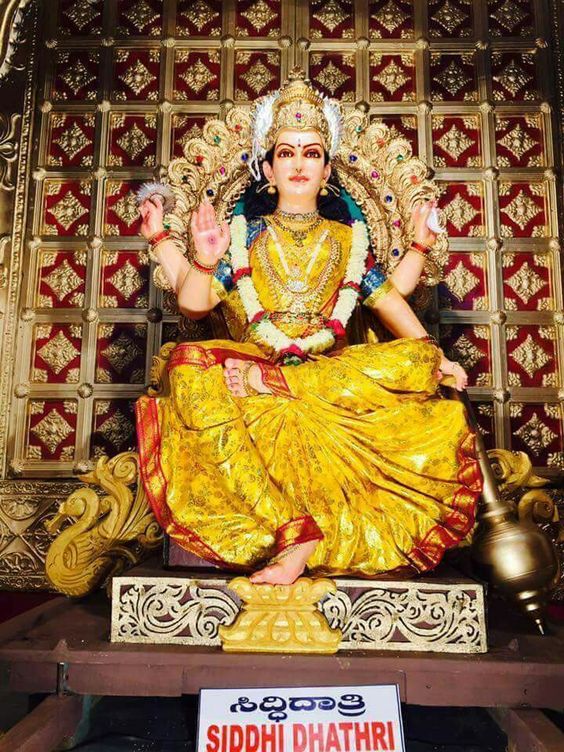
The third, meanwhile, is धात्री, which is once again a slightly differently pronounced homophone – and which has, most interestingly, a meaning-field which includes the notion of both a Mother and the Earth (most appropriate, given Ma as ‘Earth Mother’ in a number of guises – including, as our previous works have discussed, Parvati most directly, and obviously also Prithvi Ma, and a number of others besides!) ; however, the term also encompasses in its ambit of meaning, somewhat ‘surrogate’ Mother figures – ‘Foster-‘ or ‘Adoptive-‘ Mothers, wet-nurses, and even midwives fall under this ambit. Although that last one (indeed, the last two) in particular is of a subtly different shade of meaning which shall be discussed additionally.
Now, those among ye with a certain ‘appreciation’ for the ability to think ‘sideways’ – in the ‘adjacent’, so to speak, when it comes to language and theological conceptry, will already have grasped the general implication of what I am getting at here. Yet we must make it explicit! Somewhat, at least, insofar as such a thing is possible.
ALL of the above and aforementioned meanings for these two particles – both the direct ones which are to be found without further seeking within the terms themselves, as well as the different-yet-clearly-and-evidently-related meanings of the subtly different pronunciations of Dhatri, etc. – all of these are very much deliberately meant within the name SiddhiDhatri.
SIMULTANEOUSLY!
And you thought that the rather ‘broad’ seeming meaning-field of “Kali” was potentially ‘complex’ 😛
The reader can, of course, amuse and/or enlighten themselves by putting back together various English translations from the elements contained within the above paragraph. I shall not enlengthen this piece tooooooooo much by doing so in any great detail myself.
But it is very important to consider a few of the basic ‘mythemes’ going on here, nevertheless.
For “SiddhiDhatri” is clearly not ‘just’ the Bestower of Boons. But also the bestower of Perfection – the bequeather of Liberation, in the sense that such is available to the ‘perfected soul’ … and if you cast your mind back to that analogy of cooking I proffered earlier … it may seem a strange thing to constitute the process of Sanskara, of reincarnation and progressive building upon previous lives lead, as something perhaps akin to “cooking the soul”; and yet, “stick him back in – he ain’t done yet!” does have a certain ‘flavour’ that is rather useful in getting across the idea here.
The Soul as (potentially speaking, at least – and guess what the fulfillment of that potential would be rendered as in Sanskrit 😛 ) a Work of Art … “Self-Cultivation” as the Divinely Supported – indeed: mandated, ordinated, ordained – Project for the Ages, is quite something to think about!
Not least because, when you look back over the course of the NavRatri Processional of the NavaDurgas in Their Mythic Cycle, we see that this is exactly what has been taking place over the span of same. From Ma as Shailaputri (or even preceding this as Sati, come to think of it) – through to Ma as SiddhiDhatri [that is to say, the nascent and neophyte, somewhat, Daughter of the Mountain, through to the Mother of the Earth – a ‘beginning’ to a ‘fulfilment’, a ‘seeker’, to the ‘Truth’, and a ‘rebirthed ember-emanation’ [in multiple senses of the evocative nature of this term – consider just what it was that lead to Lady Sati dying-then-reincarnating … as Princess Parvati as Lady ShailaPutri] right back through Transcending Inferno (recall my commentaries on .. a number of Devi Forms in the course of these Nine Nights, come to think of it) eventually ultimately up to Adi ParaShakti Indeed!
Gaining powers, experience, enlightenment, and the ‘pressurization’ which forms those self-same (so to speak) ‘ashes’ , the ‘carbon’ from which all life [and much in the way of ‘structures’ and ‘civilization’ – and, for that matter, many wildernesses and forest terrain in particular!] we ken is ultimately made , as well as the impressions of so much art and illustration and literature upon the ‘page’ or the ‘cave wall’ or the ‘forehead [in the case of Vibhuti markings] … via which this ‘carbon’ bourne of ashes … is ultimately rendered – ‘transfigured’ [and here I am perhaps emulating a Christian theological term] – indeed into the Diamond .. the ‘perfect form’, the ultimate hardness, the ultimate cutting, the ultimate self-refracting and self-reflecting lattice-work that is therefore ‘complete in and of itself’ … and, not at all coincidentally, one of the mighty translations of “Vajra” – hence and whence the “Vajra” of “Vajrayana” and such in Buddhist post-Vedic developments upon the Term; and why it is an ultimate weapon, and invincibile, indestructible armour [c.f one of the meanings behind the Theonym of Bajrang Bali – Lord Hanuman .. not simply ‘wielder of the Thunder Club’, but The Invincible!] – the ‘flawless soul’, the ‘flawless being’, against whom None in existence can ultimately stand!
All of this is – ultimately, in both senses – the Perfection of the Being, the Essence, the Elements & Energies (indeed, the Universe), the Soul.
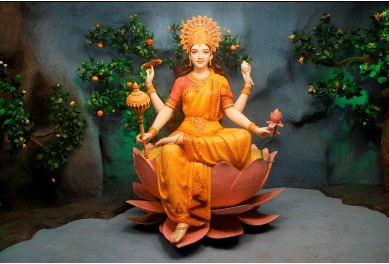
Whether you choose to take the ‘growing bonsai mountains’ (a Terry Pratchett reference there, to the rather excellent ‘Thief of Time’) view, of the soul, and one’s life (lived throughout, perhaps paradoxically, many lifetimes), as being ‘self-cultivation’ in the manner that one might attempt to grow and shape a garden (or that aforementioned bonsai mountain) over the span of many years into the shape one finds most pleasing …. or whether you take a rather more ‘removed’ view, which instead chooses to see the ‘self-cultivation’ being an exercise carried out not so much (or at least, not only) by the “self” in question – and instead, an act of Divine Artifice [I recall both something said of/to me by somebody presenting themselves as an oracle, a seer, in that Shaivite instance – that I was ‘carved’ by Mahadev ; or the related maxim “I am a living weapon – crafted by the Hands of a God” ; and, for that matter, the Nordic perception upon some of the various Actions of Lord Odin in a bid to craft better and better warriors for the War At The End Of The World].
Or, perhaps, as a ‘both’ position, something akin to the way in which a child’s growing up entails the active agency of both Mother and Child in the course of guiding and shaping that individual into the person they shall later become. This last, probably, is something closest to the ‘truth’ of it – after all, it’s ultimately ‘our choice’ whether we listen to our parents .. just it is (within the bounds of ..er .. ‘material constraints’, ironically in this case) their choice to a reasonable extent as to what they teach us, what schools or other contexts they place us in … at least in the early (and often most crucial) years.
Yet I have perhaps digressed.
My point is that Ma as SiddhiDhatri can bestow Enlightenment and the guidance that will eventually lead us, too, to Perfection. Liberation, or Moksha (and the two do not always mean the same thing – but that is a metaphysical/theological discursion for another Night!). But also, ‘Empowerment’.
For you see, in the Hindu understanding of such things, that is what many of these ‘Siddhis’ actually are. Outer [or, rather, inner-to-outer] manifestations of a more potent inner radiance. In just the same manner that a furnace, when stoked, shall produce ever more heat, light, smoke, steam, and motion if it happens to be affixed to a turbine.
The soul, the being, the person, the purpose, is the furnace [I may be implicitly referencing the Upanishadic ‘Five Fires’ doctrine here, also]; the ‘Bestowment’ is the process of increasing its inherent ‘energy’ and the self-mastery to safely project these out, through the tools, the outlets which She can give us (like that aforementioned turbine, perhaps – at the dangers of slipping into a sort of teleological “techno-theology”); the “Siddhis” are the actual manifestation and enactment of this increase, this growth and somewhat change in inner ‘essence’.
Taking what was there beforehand [and, to be sure, in a not dissimilar manner to how Ma as Kushmanda provides the Spark to the Sun – so, too, does She provide the initial fire, the initial radiance, to the Purusha .. whether God or Mortal or indeed Material Universe alike], and causing it to grow into what it can, it should, it must be.
And, in the process, unlocking the “ecstasy” – in the Greek-Heideggerian sense, of “ex-stasis” [‘outside of time’ – permanency, but also the complete absorption in Doing What One Was Created To Do … the pleasure of ‘self-realization’ where we seem outside the flow of ordinary events precisely because these are, to us, no longer “ordinary events” in which we are engaged in – they are our Destiny, our Fate, our Calling .. we are Being All That We Can Be – quite literally, at the upper end of the path of which I am speaking]; which surely must correlate with SiddhiDhatri’s ‘Bestower of Bliss’ [Ananda in various, indeed, all senses and levels; for such it is to approach the World-Axis … although this can also entail hanging in torment, perhaps for another period of Nine Nights, in pursuit of such a Siddhi as the Power of a Language-form – Vak, or Runes …. ]
Siddhis – that is to say, the supernatural powers which She is regarded as possessing absolute mastery over – are not only something developed within and bequeathed to humans, however.
They frequently turn up in scriptural and other sources as potencies which other Deities are capable of both developing and manifesting in the course of Their mythic arcs, often in direct proportion to Their Own Pathways ‘back’ upwards toward Their full and fully self-understood (that is to say, enlightened) Divine Natures.
The best example of which, perhaps, is Lord Hanuman – Who is rendered amnesiac about His True Divine nature, and along with it loses His knowledge of the Siddhis which are otherwise intrinsic to His Divinity and ‘Personhood’ – fated only to start ‘remembering’ them, these powers, as He learns to engage in the selfless/serious-minded service of others, and more properly carry out His appointed role within the Cosmos. [Bajrang Bali as mentioned above; also illustrates the core element of Hindu approaches to this phenomenon – the Diamond, as ‘perfected’ and shining forth in radiant splendour, with the potency of the Divine Thunderbolt and similar indestructibility as a result of its correctly arranged internal structure; but also, as applies that Being especially, something my Didi once said about being a divine spark having a human experience – encountering Piety, at least in part, as the effort to remember , be reminded who and what you are]
Curiously enough, another shining illustration for the concept – which also focuses more upon devotional energy, striving and effort [‘Tapas’ – linguistically connected to words for ‘Heat’, ‘Light’, and ‘Flame’, and coming to mean “penance”, “austerity”] in order to attain the Siddhi, the Boon in question, from the Beyond – comes to us from Hanuman’s Father: Shiva-Who-Is-Odin.
This has been spoken about in a little more depth in my previous “To Speak Is To Uphold The Weight Of The Universe” article comparing several Indo-European perspectives upon language; but suffice to say, it is my belief that the attainment by Odin of the Runes – also the culmination of Nine Nights of Tapas-ic conduct, carried out in particular connexion to the Axis Mundi, the World Tree [which, as considered in quite an array of my previous work, is strongly correlated with Devi – theologically, linguistically, and in other manners besides] – represents just such an Attainment of a Siddhi, as we would expect to observe elsewhere in Hindu myth.
I shall quote myself from the relevant previous article –
“Now, before going further with this explanation, it is necessary to but briefly parse the concepts of ‘Purusha’ and ‘Prakriti’ as they occur particularly in a specific Shaivite-Shakta context. A more indepth and, er, ‘accurate’ accounting for these words would take up an article many times the size of this one; for our purposes, we’ll simply run them as ‘Body’ and ‘Spirit’ respectively. [I stress that they can also mean .. other things, especially in relation to each other, including, somewhat peculiarly, almost the other way around] (Male) ‘Purusha’ in a cosmological context referring to the ‘universe’, the ‘world’ itself [and, indeed, there have been some academic comparisons made between the course of the Purusha Sukta and the Slaying of Ymir, in each case for a sort of cosmogonical effect], and Prakriti, here conceived of as the feminine particle, being an investiture of something supernal, a thought-form, an ‘essence’, from beyond/outside it.
So how does this relate to the Runes? Well, we’ll sketch out our thinking in more depth in a later article, but suffice to say that as the Runes are fundamental to reality, indeed precede it in an external sense, as part of Orlog [‘Orlog’ – Over-Law, Supernal, Outside/Above/Beyond-Universe Law – i.e. Rta], Their projection into our reality, to the Male in question [when He had briefly gone beyond, above, via self-sacrifice, tied about the Female World-Tree Axis Mundi] seems very like the above-aforementioned concept of Vak as Prakriti investing into the Universe, Purusha. And would also, as it happens, in a certain sense perhaps typologically mirror the way in which Freyja/Frigg teaches Odin magical secrets; or the famed Devi Sukta of the 10th Mandala of the RigVeda talks about the Divine Queen empowering the Man That SHE Loves & Chooses.”
As you can see, when we consider this in our #NAS framework of belief, the unifying thread of the two Nordic elements drawn from here – the Attainment of the Runes By Odin, and the Teaching of magical potency to Him – is that both are instances of Devi bestowing, donating empowerments to Her Husband.
That particular form of relationship also coming to the fore in another of my favourite Hymns of the 10th Mandala of the RigVeda – the ‘Jnanam’/’Vak’ sukta, detailing the development of language and the granting of its intricate understandings and competencies to the Seers (Rsis): “But to another hath she shown her beauty as a fond well-dressed woman to her husband” [RV. X. 71.4].
This, as I have noted above, goes with an array of the core theme-expressions of the DeviSuktam [RV. X. 125] – which, in amidst an array of other statements about how it is that Devi [as Vak, in some accountings, but I would more properly suggest as (Adi)(Para)Shakti, and thence through Vak, amidst further Devi engagement(s)] supports and empowers the various Gods, those undertaking proper and appropriate pious action, indeed the Universe and the Heavens and the lines of heredity and descent themselves … is this line: “I make the man I love exceeding mighty, make him a sage, a Ṛṣi, and a Brahman.” (variant translation: “whomsoever I choose, I render him an exalted one, make him a ṛṣi, make him Brahman or make him highly intelligent.”) [RV. X. 125.5].
So right there, we have exactly the role and some of the saliency of Devi as SiddhiDhatri – supporting Gods and certain mighty mortals, to carry out their proper and apportioned roles, through the bestowing of their (and Their) relevant Powers [Siddhis]; also encouraging, facilitating, educating even, beings to become more enlightened, more powerful (Power-ful, indeed – in touch with Shakti and thusly imbued … as is the Universe Itself at Its Highest Arc, and thence back all the way down); and rewarding the pious and devoted conduct of those who are making their own eventual journey up the Mountain of existence, of life, the universe, and everything.
Glorious!
But to return to one of the metaphors deployed in the course of them hymnals, and our own #NAS theological explication, we see something that is once again core and immanent to prominent Hindu perspectives around the mightiest of the Gods – the Trimurti – and Their Wives; Who, per this interpretation, are granted to Them by Shakti, as … I hesitate to state “augments”, or “completers of Them”, because that reduces the female ‘component’ to just that – a “component” added to something which already exists, rather than the “other part” which makes something into what it truly is. And if there is anything we should not be doing in a Shakta theological commentary, it is implicitly ‘diminishing’ Woman to a mere adjunct.
The better perspective perhaps, is that elucidated via the quotation around Purusha & Prakriti from my article, as reproduced above. Wherein the ‘encounter’ between Goddess and God is an investiture of essence which makes somethings [plural] that have a prior and somewhat independent existence, into something greater than either is on their own.
In the case of Shiva and Parvati, this is #Ardhanarishvara.
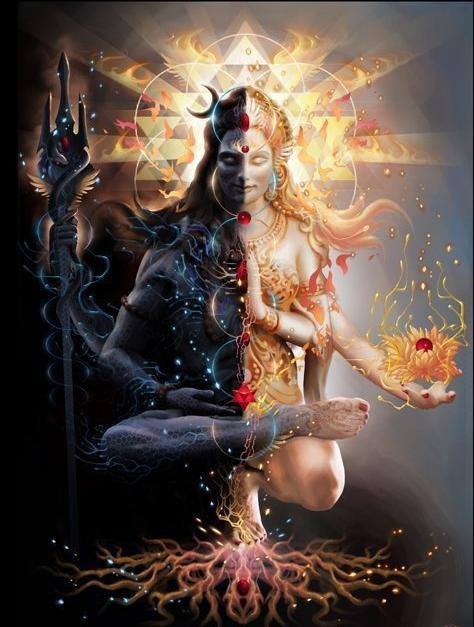
Ardhanarishvara as Ishvara – The Over-God Who Is Both Parts As Over-God, to translate a little figuratively.
Or, phrased another way, and as detailed in some of the earlier articles of this series, the reunification of Parvati with Shiva is the ‘reconstruction’, the ‘reintegration’ via which They resume Their position at the apex of the world. Two halves which make the Axis Mundi whole and turn again. This is also what is entailed in the discussion between Brahmacharini [Who, it should be remembered, is undergoing Tapas – as, after a manner, Shiva has been via His austere forms of living; although He perhaps did not know that He was also, through such, working His way back towards the Goddess … Who was also winding Her way back towards Him] and Lord Shiva wherein Shiva finally realizes/remembers/is convinced that the young aspirant standing before him is infact His Devi, His Wife, His Other Half – for it is a theological debate upon the notions and natures of Prakriti & Purusha … which, in a certain way, helps Shiva to ‘understand Himself’ [‘recollect Himself’] once more [c.f also RigVeda X. 125.6 , coming directly after the line around making the man She loves “mighty”, “a Sage”, “a Rsi”, “a Brahman” – “I bend the bow for Rudra that His arrow may strike and slay the hater of devotion.” Part of what makes Rudra … well … Rudra, is that He is an Archer; a Destroyer – hence, here, the Archery, the Destruction can only really take place via Devi’s investiture and active engagement with and through Him! The Trishula, too, as correlate in symbolism to the Bow, is closely and directly relevant here – as noted in previous commentaries, as the Mountains, the Mountain-Spear, the Axis Mundi within His Mighty Hands, HERSELF!]
The famed sage Adi Shankara phrased it thus in the opening couplets of his Saundarya Lahari [‘The Waves of Beauty’] –
“sivah saktya yukto yadi bhavati saktah prabhavitum
na cedevam devo na khalu kusalah spanditumapi —
“Only if conjunct with ‘Sakti’would ‘Siva’earn the privilege to
become overlord; otherwise the God is not able even to stir.”
[variant translation:
“Lord Shiva, only becomes able.
To do creation in this world along with Shakthi
Without her, Even an inch he cannot move,
And so how can, one who does not do good deeds,”]
The next lines are also highly relevant to consider – as they state that only one who performs noble, meritorious, good deeds, who is pious, is able to engage with Devi.
Which, if you should recall from some paragraphs prior in this piece, is precisely what is entailed via the ongoing life path of Hanuman, as an example; and the general principle which it enjoins of positive deeds and pious expression – the cultivation of both inner light and outer radiancy of its expression, as “Krinvanto Vishvam Aryam” and Sanskara of the Soul to correspond therewith. “Inner Development” and “Self-Cultivation”, therefore, even leaving aside the ‘making whole and illumination of the world around and outside us’ aspect – is a (re-)connection with the Divine inside us, the lighting of something akin to a Diya lamp [the Agni within – the Conduit to the Upplands and Beyond], that almost bypasses the world between us and the Highest (Uber/Over) Heaven. Except, of course, insofar as it radiates back out again; and the ‘golden threads’ between us and It, forming chords [in multiple senses of the term – sonic theology is also veer-y much in affect!] through and to the supernal realm.
So therefore, we have two somewhat related approaches under discussion here. The establishment of a relationship with Devi by … marrying a Goddess; and/or via proper and meritorious, pious conduct, ultimately directed thereup and thereto.
One of these is, for obvious reasons, rather more easily attained than the other. For even the man who otherwise has nothing, can still have Faith. Indeed, it has often been observed that some who are amidst the most brimful in abundance in that regard, are so precisely because or otherwise alongside the fact they have so little else (by accident or by design). This does not mean that poverty and sitting naked on a mountain-top is the only, or perhaps even necessarily the*best* way towards such a state – indeed, I would contend that [and oddly enough, this is somewhat borne out in my reading of the Reunification Myth of Shiva & Parvati], doing so as a “renunciation” of the world is actually almost the wrong way to go, for many – as it abdicates much of the possibility of actually doing the “good deeds” side of things, in favour of a more exclusive focus upon, if not “the self”, then at least, an individual. [In terms of my aforementioned reading of the relevant Shaivite-Shakta myth – Shiva’s retreat to the Mountains in solitude, while necessary for Him in that circumstance, is nevertheless something that has to come to an end, for the good of the universe itself overall]
But in either case, and most especially in the convection-zone that is both [a convection zone, after all, entailing a rise and a cycle of such same, as a direct result of heat, Tep-, Tapas, remember?], one should strive to be worthy; and whether this entails that one actually somehow winds up attracting the attention of a Goddess for a direct interaction or prolongued engagement, perhaps being Chosen by Lady Vak as aforementioned – or whether this simply results in the indirect strengthening of soul to the point that this or that Siddhi, or other manifestation of the superior soul is manifested … well, it shall surely be the result of making one’s self worthy of Divine notice. She, after all, is “the gatherer-up of treasures”; Who also “load[s] with wealth [‘donations’] the zealous sacrificer” [RV. X. 125. 2 and 3, respectively].
And, indeed, one does not necessarily have to be ‘perfect’ to be ‘moving in the right [rite] direction’. A woman will often see the potential and the promise in a man, even if it is not directly realized at that particular point in time – will therefore act, as we have said, to make him better over the course of their engagement. This, too, we can see in those relevant RigVedic hymnals – with especial reference to the notion that it is Devi, in whichever Form, making the male in question mighty and knowledgeable and wise and powerful. Of course, this should not necessarily be taken as a radical statement of egalitarianism – in these cases, it is nevertheless a small and select few who are Chosen in any such manner; building upon pre-existing elemental, essence-ial competencies and characteristics, and fundamental foundations of being in the first place, we can likely surmise. For it is not to be held to be the case that Devi makes an ordinary man Rudra – even though, in an important and significant sense, it is Devi Who makes Rudra Rudra. Rather, it is Rudra Who is made the greater, Shiva Who is made ArdhanarIshvara.
And it is the great man, greater still, who recognizes that his role in life is to live in the best possible imitation of these mythic over-truths – picking up and resounding out their resonances … without seeking to confuse, to delude himself that he is their ultimate source.
The Lesson of SiddhiDhatri for the Devotee, then, is quite simple.
Find Devi.
And go both within and beyond your self, to do so. For there may be a ‘universe’ within you – but more aptly, there is a universe around you, and you are connected within it to the universe above you and even further (t)hence beyond.
Allow Her to help, become Guided; and note that the marble .. chisel .. can hurt a bit in its striking, its sanskara – sculpting.
Become Worthy of Her interest, Her assistance, Her beneficence, Her Support. Her Empowerment [and it is not at all coincidental how we would often translate Shakti into English – nor how the path of Shakti up the spine to the Crown is customarily en-traced out, leading ultimately to the Radiance of the Sahasrara Chakra, the Resoundingness of the MahaNada Sound pealing out across the Cosmos from the First through to the Fabric through to the Last – just as ChandraGhanta represents a crown of both holy light and the pious emanation of the striking of a Temple Bell … so, too, does this concept speak to becoming in-touch with, and a radiator out of what is drawn down from this connexion, this conduit, with the Supreme].
So therefore, who is Devi as Siddhidhatri, and Where can we find Her? Well, some obvious answers have already presented themselves:
In addition to the both obvious and subtle instances of the direct appearance of the Goddess [whether er .. directly, or through what is meant by Vak – ‘divinely resonant’ vocal/linguistic expression; or for that matter, that Mata, through other forms of Darshana] – wives, mothers, Mandirs & Goddess(es), other teachers, refiners of our beings and imparters of wisdom, devotional practices, meritorious deeds, pious action, spontaneous flashes of Divinely Revelated insight [provided that that is actually what it is, in any given case … delusion, too, can look like radiancy to those who dearly, desperately, are Trying To Believe [as, perhaps, contrasted with Fox Mulder’s “Want To Believe” – which implies an active openness, if not necessarily a yearning credulency that would be entailed in “Trying”]].
In all of these, are to be found various and varying directnesses of pathways [back] to Devi.
And this should not at all surprise us. For what is the Role of Devi as SiddhiDhatri?
It is to ‘inspire’ us, to ‘guide’ us, to ‘nurture’ us – particularly if we’re up to listening and taking direction, acknowledging our Ma is, in fact, right … and Has the Right.
But also, to “bring out in us” [hence ,धात्री as ‘midwife’] and ‘put into us’ [hence, धात्री as ‘wet-nurse’, hence दातृ as in ‘donor’] That Which Needs Be There! The INSPIRER OF GREATNESS; the Foundation [दातृ – ‘founder’; धात्री – ‘earth’] and Inceptor of the inexorable rise of the Chosen to the status and faculty of a Great Man, a Sant, a Jivanmukta [which, per this enhanced perspective, is not truly one who is “self-liberated”, any more than there can ever be such a thing as a truly ‘self-made man’. But rather, one who has been blessed and empowered from Above and Beyond by HER to reach his otherwise unparalleled and often semi-near inexplicable state and status of development. It does, of course, retain the other sense of “self-liberated” – as such we should expect entailed in the axiomatic moving “beyond” of the limited nature of an earlier human self].
SiddhiDhatri, is therefore the Perfect Mother .. both insofar as She is the Mother (of All) Who Is Perfection, and also as She is the Mother (Foster Mother, somewhat, also, to the Devotee -for We also have our birth-mothers to acknowledge and regard! As the greatest act of piety, indeed!) Who Is Perfect For and To Us, Her Devotes, Her दत्रिम सुत, Adopted Children. SHE is HiranyaGarbha – the Perfect (Golden) Creator. And even afore SHE as (Maha)Kali brings about the end of it all, SHE also oversees and guides our pathway (our PathiWays) upwards towards, as does any nurturing mother, ‘maturity’ – the superior state, the more full ‘realization’ which is who and how we are supposed to be.
In terms of the Siddhis Themselves, it is as the continuance of what was said in last night’s Ma as MahaGauri piece – that just as ‘white light’ contains within it all other colours, and just as MahaGauri shows that She has the self-knowledge and self-mastery to ‘bring out’ the relevant ‘facing’ as and where and when necessary with reference to HerSelf … so therefore is Ma as SiddhiDhatri the ‘furtherance’ of this. The ‘perfection’ of it, you might even say.
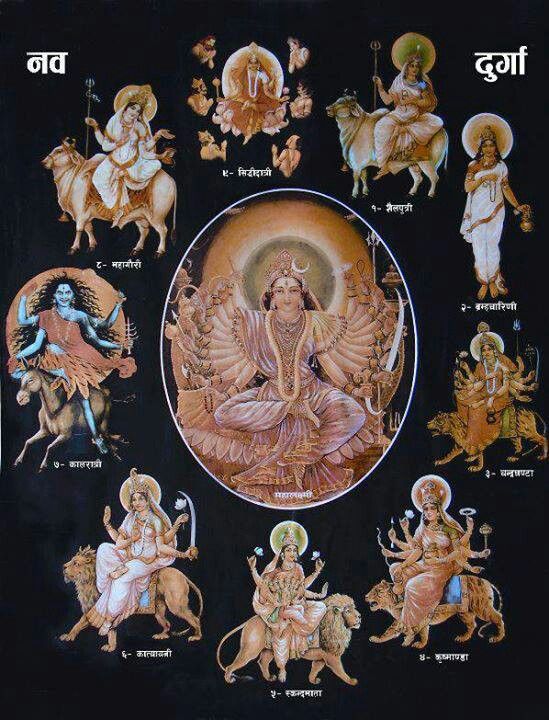
For here, not only are all the Siddhis to be found, but They are so completely mastered (including also as embodiments/qualities/emanations/projections/investments of HER), as to be impartable out to others, at will. Indeed, as Will [this, too, is a somewhat figurative rendering for Prakriti].
SHE Has Power over the Siddhis of Understanding, Piety, Enlightenment, and Knowledge – for She IS Understanding, Enlightenment, Piety, and Knowledge [Especially ‘Self-Knowledge’, ‘Self-Realization’ – for She is your Master and ultimate architect, author, artist, of our being and becoming]. Indeed, building from both of the RigVedic hymnals cited above, She is both the means of communication and examination/realization, and the means via which the results of all of the above are actually incorporated into our selves, our being(s), our perception(s) of the world – and therefore, our worlds, which are thusly also reshaped via what we put back out into them again, in turn. The “convection zone”, as previously noted, is also a “cycle”.
SHE Has Power over the Siddhis of the Material, those of growing, changing, shrinking, shrouding [‘seeing’ in addition to ‘perceiving’], increasing or eschewing entirely the density of, altering the position within space or even time of, one’s being … for SHE IS the Tapestry and Fabric of the Universe [and so much more, beyond, all-permeating, as well], Maha-Maya, and therefore in ultimate command and control of All That Might Transpire Within Her Domain.
Indeed, SHE Has Power over the Siddhis of Command, Control, and Conquest – for SHE IS Command, Control, and Conquest, Itself [c.f RigVeda X. 125.6 , amidst many many other sources].
It is often said, for some reason, that “those who can, do – those who can’t, teach”. This is a ridiculous axiom, as while it does encode the possibility for one who is no longer in a position to “do”, to nevertheless still be in a position to guide, to pass on, to impart important wisdom and learned experience as to how to “do” to those who are about to (i.e. to “teach”) … it completely discounts, especially as it is often or ordinarily employed, the rather high likelihood that those who are teaching, either have been capable of “doing”, and have “done” in the past – or, for that matter, are very much still doing, even now, whether inside or outside of the classroom [and, for a certain sort of teacher, the whole world is a class. Both in the sense of constantly, continually teaching .. and also in the sense of learning, themselves, from all over the place, almost assuredly at the same time].
The Myths of Devi more than demonstrate exactly this principle in action. For while She is unquestionably the greatest possible Teacher – She is also, and not coincidentally, the greatest possible Doer. Both through setting All in motion, and through direct interventions within the Universe thus ‘in motion’.
And woe betide the unutterably unctuous specimine who would forget that.
For they are liable to find themselves … not through a process of self-realization … but rather, on the wrong end of the Trishula.
For such it is, both symbolically as well as literally, to seek to oppose the veer-y Force of Creation, the Universe, Destruction, Herself.
Iconographically, Ma as Siddhidhatri is relatively simply depicted; tending towards having four arms, wielding a Gada [mace – lordship, martial power, justice], Conch-shell [a war-horn, and also a ritual implement utilized to call people for the actions of piety; in either case, a resounding and rallying sound], Lotus [symbolizing purity, endurance, immortality, and rejuvenation], and Sudarshana Chakra [representing Vision, the Wheel of Time, the Circle/Cycle of the Universe, and the Rolling Wheel of Dharma – also therefore Supreme Lordship, Chakravartin]. She is seated upon a Lotus, or more rarely, Dawon, Crowned, Radiant, and often being worshipped directly by various mighty Gods arrayed about Her.
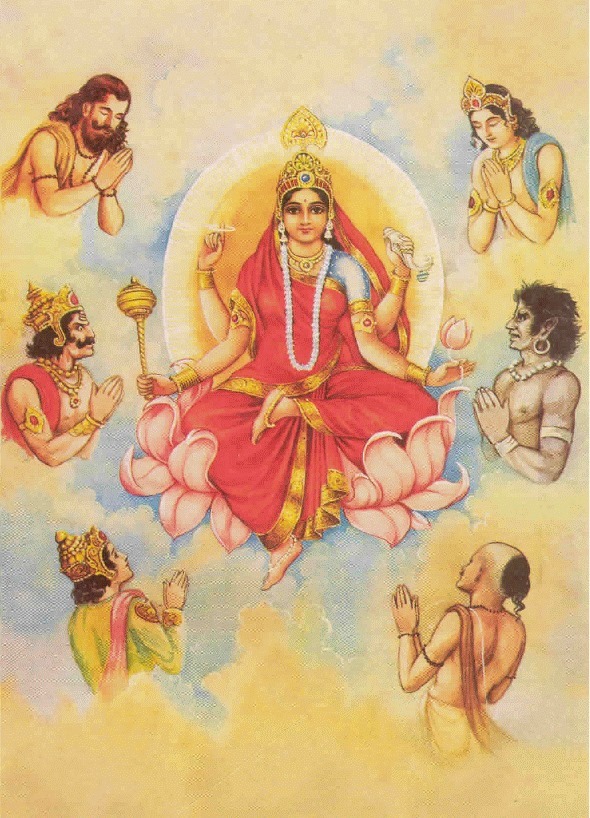
The meanings of the above, ought be abundantly clear, based upon the preceding nearly seven thousand words worth of commentary. They denote the Supernal, the Supremacy, the Eternity, the Powerful, the Pious; the Immanence, the Transcendence, the Active-Exercise of all of the above; Her most august position at the heart of it All.
There are far more complex and ornate depictions of this or that particular form of Devi out there, so it may be asked why – as She is Queen of All – She is not more usually represented in much more ‘expansive’ fashion; say, the eighteen plus arms of some Murtis, bedecked with every implement found in the Armoury of Durga of legendary scripture, and then some.
And the simple answer to this is – how do you really represent She Who Is Everything?
Again, quite simply – She is everything. And so, this symbol is but a smaller placeholder. Beautiful to look at, elegant in its succinctness, but ultimately, with all – and well beyond all behind this iconographic depiction for us to also gaze out at, and up at, in ever-expanding Wonder.
Jai Mata Di ❤
Hail to All And Everything
Jai Jagadamba
Who Is The Mother Of All
Jai AdiParaShakti
Who Is.
जय माता दी ॥
